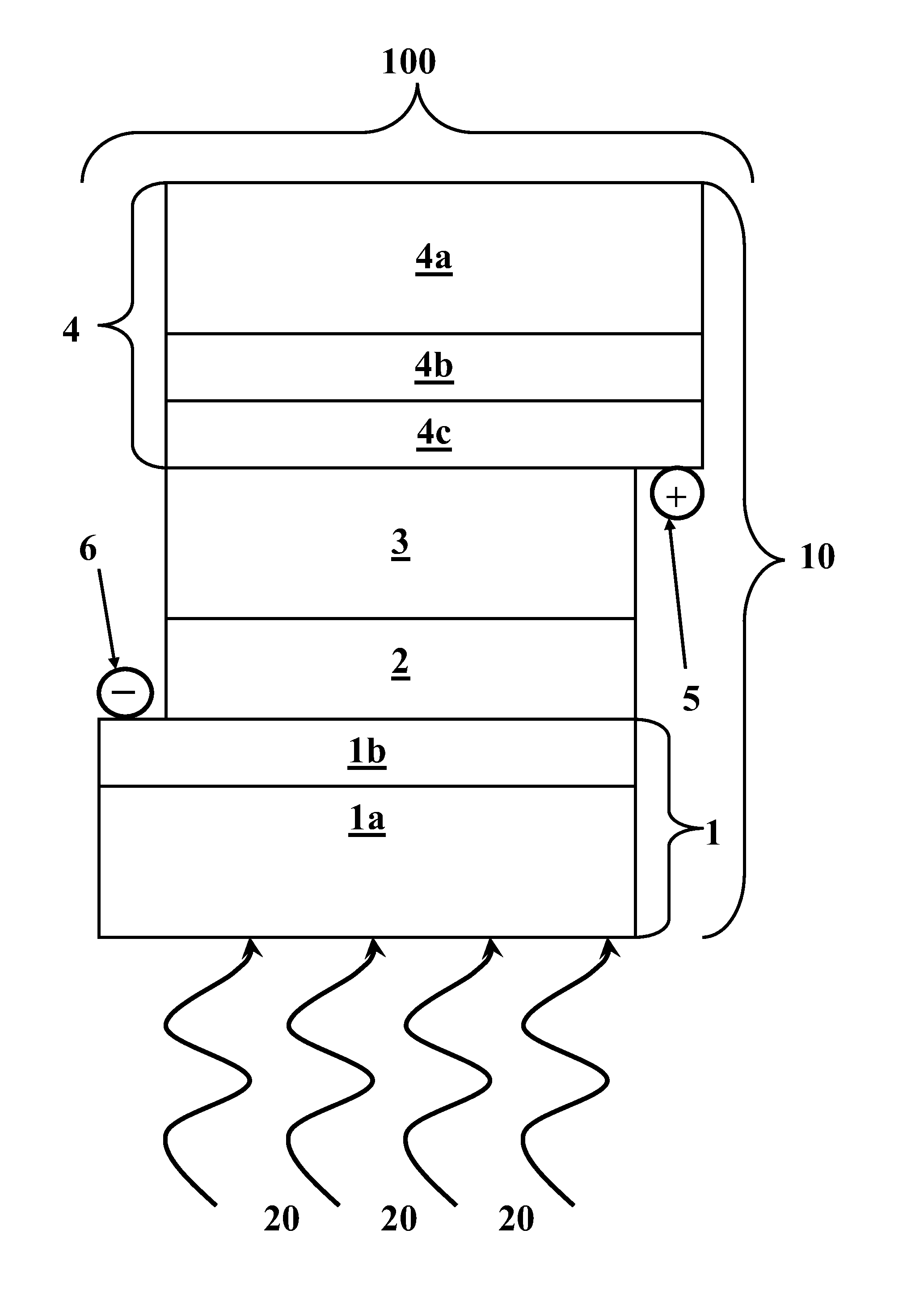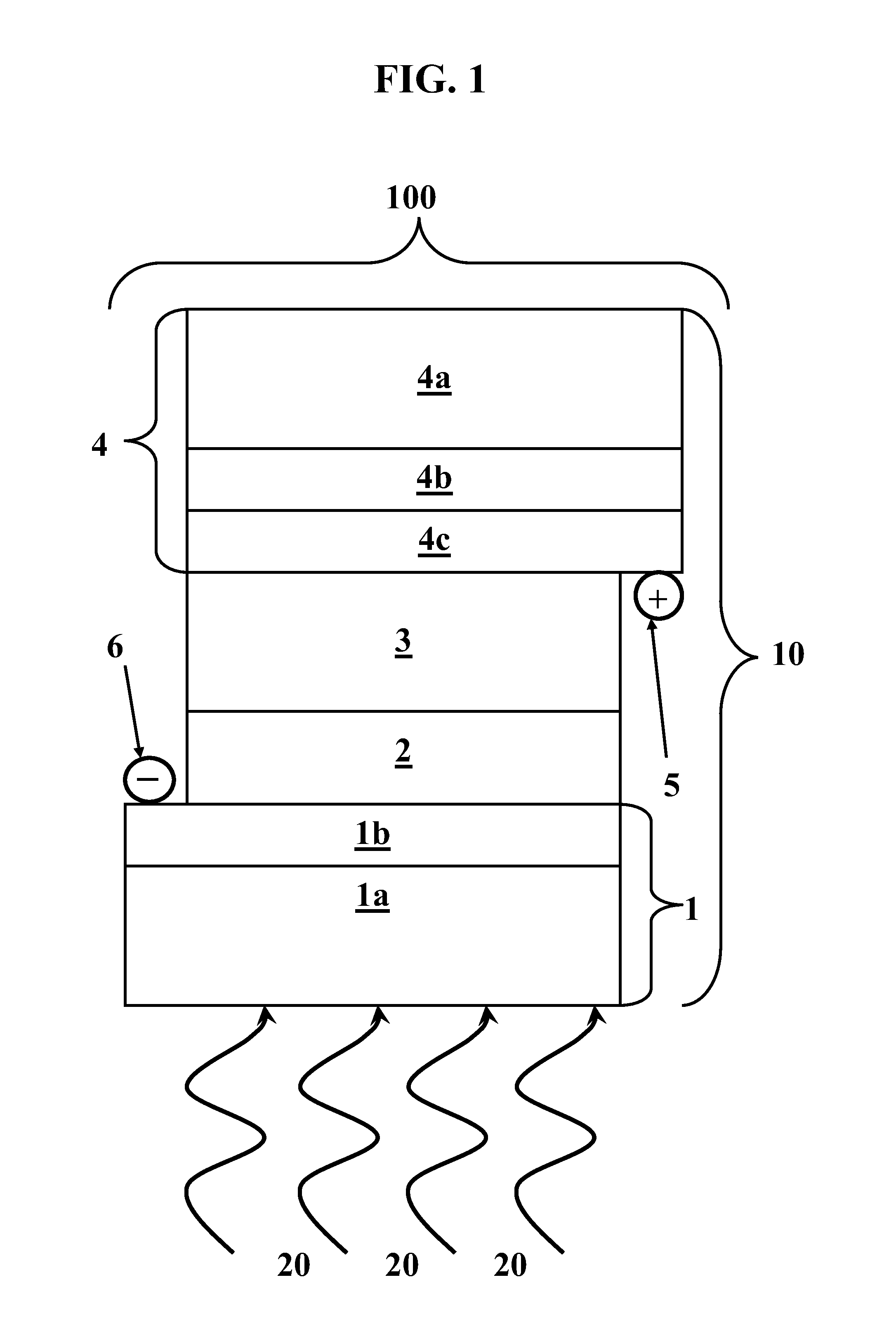Quasi-solid-state photoelectrochemical solar cell formed using inkjet printing and nanocomposite organic-inorganic material
a photoelectrochemical and solar cell technology, applied in the direction of solid-state devices, capacitors, electrolytic capacitors, etc., can solve the problems of wasting an important part of the surface of the cell, reducing the efficiency of the cell, and reducing the quantity of adsorbed organic photosensitizers. , to achieve the effect of increasing the quantity of organic photosensitizers and increasing the overall efficiency of the cell
- Summary
- Abstract
- Description
- Claims
- Application Information
AI Technical Summary
Benefits of technology
Problems solved by technology
Method used
Image
Examples
example 1
[0048]A first exemplary PECSC 100 was formed comprising the following layer stack 10. A glass plate 1a bearing a SnO2:F layer 1b was used as negative electrode 1 and as a substrate for deposition of titania film 2. Positive electrode 4 included a glass plate 4a bearing a SnO2:F layer 4b as a substrate for deposition of a thin layer 4c of platinum. Positive electrode 4 included a semi-transparent Pt layer 4c of a thickness of about 200 nm formed by spin-casting of an isopropanol solution of hexachloroplatinic acid.
[0049]On negative electrode 1, a colloidal solution was deposited from which titania film 2 was produced after calcination. The colloidal solution was made as follows: about 3 g ethanol (“EtOH”) were mixed with about 0.71 g Triton X-100. Then, about 0.64 g AcOH and about 0.36 g titanium isopropoxide were added under vigorous stirring and ambient conditions. After about 30 minutes of stirring, approximately one drop of this colloidal solution was placed on negative electrode...
example 2
[0053]A PECSC was formed with the same components as that of Example 1, using the same proportions of the employed reagents and the same methods of preparation, with the exception that, in preparation of solid gel 3, propylene carbonate was replaced with an approximately 1:1 mixture of propylene carbonate and ethylene carbonate. Under illumination by simulated solar radiation of about 100 mW / cm2, PECSC of Example 2 produced about 11.6 mA / cm2 short circuit current, about 0.62 volts of open circuit voltage, a fill factor of about 0.69, and an overall efficiency of about 5.0%.
example 3
[0054]A PECSC was formed with the same components as that of Example 1, using the same proportions of the employed reagents and the same methods of preparation, with the exception that, in preparation of solid gel 3, propylene carbonate was replaced with poly(ethylene glycol)-200. When illuminated by simulated solar radiation of about 100 mW / cm2, PECSC of Example 3 produced about 12.4 mA / cm2 short circuit current, about 0.61 volts of open circuit voltage, a fill factor of about 0.7, and an overall efficiency of about 5.3%.
PUM
 Login to View More
Login to View More Abstract
Description
Claims
Application Information
 Login to View More
Login to View More - Generate Ideas
- Intellectual Property
- Life Sciences
- Materials
- Tech Scout
- Unparalleled Data Quality
- Higher Quality Content
- 60% Fewer Hallucinations
Browse by: Latest US Patents, China's latest patents, Technical Efficacy Thesaurus, Application Domain, Technology Topic, Popular Technical Reports.
© 2025 PatSnap. All rights reserved.Legal|Privacy policy|Modern Slavery Act Transparency Statement|Sitemap|About US| Contact US: help@patsnap.com



